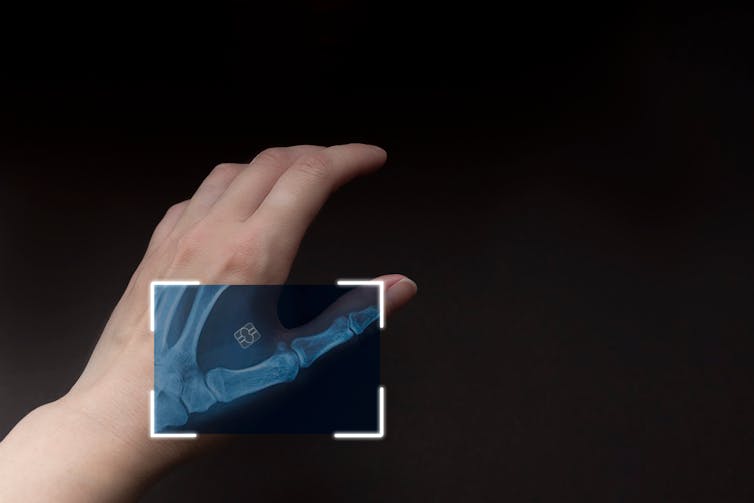Source: The Conversation – UK – By Colin Manning, Postdoctoral Research Associate in Climate Science, Newcastle University
Storm Floris made landfall in northern parts of the UK on the morning of Monday August 4 2025, bringing intense rainfall followed by severe winds throughout the afternoon. The Met Office issued an amber weather warning for much of Scotland and yellow alerts for parts of Northern Ireland and northern England.
Affected areas can expect 20mm–40mm of rain on average, with some areas of Scotland potentially receiving up to 80mm. Wind speeds in exposed and elevated regions could reach 80mph–90mph, while gusts of 50mph-60mph are forecast for much of Scotland.
The storm’s defining characteristic is the unusually strong winds for August, a time typically less prone to severe wind events. The odd seasonal timing has increased the risk to the public, as more people are outdoors, travelling for holidays or staying in campsites. In addition, trees remain in full leaf, making them more likely to be brought down by high winds.
Authorities are anticipating significant disruption to transport and electricity networks largely due to falling trees. This is underlined by recent research showing an increased risk of large power outages during windstorms that occur in summer. A large amount of debris on the ground from trees may also block drainage systems and contribute to localised flooding.
Persistent strong winds will combine with periods of heavy rainfall for the duration of the amber alert, which expires at 23:00. This will create difficult conditions for emergency workers and prevent access to affected locations if roads are blocked, potentially prolonging disruptions to travel and power networks.
Is this typical of summer months?
Storm Floris carries all the hallmarks of a classic mid-latitude storm. These develop due to sharp temperature contrasts between the northern and southern Atlantic Ocean and intensify under the influence of a strong jet stream. This is a core of fast-moving air high in the atmosphere that stretches across the Atlantic and often steers storms towards the UK.
Such conditions are unusual for the summer months, when warmer Atlantic sea temperatures typically weaken these temperature gradients and shift them farther north, closer to the polar regions. However, it is not uncommon for such storms to occur in August.
Notable ones in the past five years include Storm Ellen, which extensively damaged electricity distribution infrastructure in Ireland and led the Irish meterological service to produce and red and amber weather warning for southern parts of Ireland. Previous storms in August cancelled the Boardmasters music festival in Cornwall in 2019 and closed two stages of Leeds festival in 2024.
Floris is classified as a Shapiro-Keyser cyclone, a type distinguished by a warm core encircled by colder air on its north, west and south sides. This structure is visible in the way the storm’s frontal system wraps around its centre, forming a characteristic comma-shape in the clouds around the cyclone centre. Storms of this kind are responsible for a significant number of the UK’s most damaging wind events.
These cyclones often feature sharp pressure gradients and strong low-level airflows, particularly an air stream known as the cold jet, or cold conveyor belt, which can produce severe surface winds. In some cases, they can also generate a sting jet, a narrow stream of air that descends rapidly from around 5km above the land surface, delivering intense, damaging gusts.
Fortunately, satellite imagery suggests that Storm Floris is unlikely to have produced a sting jet. However, the cold jet alone may still drive wind speeds high enough to cause widespread disruption.
These types of storms can also produce intense rainfall along their frontal boundaries, as seen with Storm Floris. Warmer summer temperatures allow the atmosphere to hold more moisture, increasing the potential for heavier downpours. In addition, the heat contributes to a more unstable atmosphere, encouraging strong convective ascents of air that can yield extremely heavy and localised rainfall.
Floris in the future
Research shows that climate change will influence the characteristics of storms like Floris, though not all aspects will be affected equally. Warmer temperatures are expected to make future storms wetter, as increased atmospheric moisture and convective activity enhances rainfall, particularly along frontal systems. However, projections of wind extremes remain more uncertain.
Climate models generally suggest a modest intensification of winter storms over the UK and a decrease in the intensity of summer storms, implying that systems like Floris could become less common. These projections are largely tied to expected changes in Atlantic temperature gradients and the behaviour of the jet stream.
That said, most long-term climate projections rely on relatively coarse-resolution models which often fail to capture key features that drive storm intensification. These include the gulf stream (a warm Atlantic Ocean current) and drivers of extreme winds including the cold jet and sting jet.
A higher-resolution model, like that used in real-time forecasting for Storm Floris, predicts more intense winter windstorms in a warmer climate. Much of this intensification is linked to stronger cold jets and a potential increase in storms that generate sting jets.
Many powerful summer and autumn storms in the UK originate from tropical cyclones such as hurricanes, as seen with Storm Ophelia in 2017. These systems are poorly represented in lower-resolution climate models, yet they contribute significantly to Europe’s most extreme windstorms.
While Storm Floris has no tropical origins, a variety of storms can affect northern Europe at this time of year. The complexity of assessing their risks remains an area of ongoing research.
Don’t have time to read about climate change as much as you’d like?
Get a weekly roundup in your inbox instead. Every Wednesday, The Conversation’s environment editor writes Imagine, a short email that goes a little deeper into just one climate issue. Join the 45,000+ readers who’ve subscribed so far.
![]()
Colin Manning receives funding from UKRI.
– ref. Storm Floris: the weather is rarely this windy in August – which makes it more dangerous – https://theconversation.com/storm-floris-the-weather-is-rarely-this-windy-in-august-which-makes-it-more-dangerous-262535













